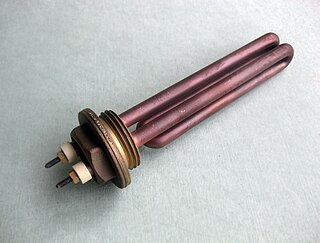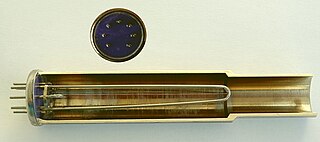
A thermocouple, also known as a "thermoelectrical thermometer", is an electrical device consisting of two dissimilar electrical conductors forming an electrical junction. A thermocouple produces a temperature-dependent voltage as a result of the Seebeck effect, and this voltage can be interpreted to measure temperature. Thermocouples are widely used as temperature sensors.

A lighter is a portable device which creates a controlled flame, and can be used to ignite a variety of flammable items, such as cigarettes, butane gas, fireworks, candles or campfires. A lighter typically consists of a metal or plastic container filled with a flammable liquid, a compressed flammable gas and in rarer cases a flammable solid i.e. rope in a trench lighter, a means of ignition to produce the flame, and some provision for extinguishing the flame or merely controlling it to such a degree that the user may extinguish it with their breath. Alternatively, a lighter can be one which uses electricity to create an electric arc utilizing the created plasma as the source of ignition or a heating element can be used in a similar vein to heat the target to its ignition temperatures, as first formally utilized by Friedrich Wilhelm Schindler to light cigars and now more commonly seen incorporated into the automobile auxiliary power outlet to ignite the target material. Different lighter fuels have different characteristics which is the main influence behind the creation and purchasing of a variety of lighter types.

An incandescent gas mantle, gas mantle or Welsbach mantle is a device for generating incandescent bright white light when heated by a flame. The name refers to its original heat source in gas lights which illuminated the streets of Europe and North America in the late 19th century. Mantle refers to the way it hangs like a cloak above the flame. Gas mantles were also used in portable camping lanterns, pressure lanterns and some oil lamps.

A heating element converts electrical energy into heat through the process of Joule heating. Electric current through the element encounters resistance, resulting in heating of the element. Unlike the Peltier effect, this process is independent of the direction of current.

An electronic component is any basic discrete electronic device or physical entity part of an electronic system used to affect electrons or their associated fields. Electronic components are mostly industrial products, available in a singular form and are not to be confused with electrical elements, which are conceptual abstractions representing idealized electronic components and elements.

A pilot light is a small gas flame, usually natural gas or liquefied petroleum gas, which serves as an ignition source for a more powerful gas burner. Originally a pilot light was kept permanently alight, but this wastes gas. Now it is more common to light a burner electrically, but gas pilot lights are still used when a high energy ignition source is necessary, as in when lighting a large burner.

A pellet stove is a stove that burns compressed wood or biomass pellets to create a source of heat for residential and sometimes industrial spaces. By steadily feeding fuel from a storage container (hopper) into a burn pot area, it produces a constant flame that requires little to no physical adjustments. Today's central heating systems operated with wood pellets as a renewable energy source can reach an efficiency factor of more than 90%.

A cooktop, stovetop or hob, is a device commonly used for cooking that is commonly found in kitchens and used to apply heat to the base of pans or pots. Cooktops are often found integrated with an oven into a kitchen stove but may also be standalone devices. Cooktops are commonly powered by gas or electricity, though oil or other fuels are sometimes used.

A heat detector is a fire alarm device designed to respond when the convected thermal energy of a fire increases the temperature of a heat sensitive element. The thermal mass and conductivity of the element regulate the rate flow of heat into the element. All heat detectors have this thermal lag. Heat detectors have two main classifications of operation, "rate-of-rise" and "fixed temperature". The heat detector is used to help in the reduction of property damage.
The thermal properties of soil are a component of soil physics that has found important uses in engineering, climatology and agriculture. These properties influence how energy is partitioned in the soil profile. While related to soil temperature, it is more accurately associated with the transfer of energy throughout the soil, by radiation, conduction and convection.

An electric match is a device that uses an externally applied electric current to ignite a combustible compound.

A thermal cutoff is an electrical safety device that interrupts electric current when heated to a specific temperature. These devices may be for one-time use, or may be reset manually or automatically.
A gas detector is a device that detects the presence of gases in an area, often as part of a safety system. A gas detector can sound an alarm to operators in the area where the leak is occurring, giving them the opportunity to leave. This type of device is important because there are many gases that can be harmful to organic life, such as humans or animals.
The thermal conductivity detector (TCD), also known as a katharometer, is a bulk property detector and a chemical specific detector commonly used in gas chromatography. This detector senses changes in the thermal conductivity of the column eluent and compares it to a reference flow of carrier gas. Since most compounds have a thermal conductivity much less than that of the common carrier gases of helium or hydrogen, when an analyte elutes from the column the effluent thermal conductivity is reduced, and a detectable signal is produced.

A flame arrester, deflagration arrester, or flame trap The term flame arrester describes a device or form of construction that will allow free passage of a gas or gaseous mixture but will interrupt or prevent the passage of flame. It prevents the transmission of flame through a flammable gas/ air mixture by quenching the flame on the high surface area provided by an array of small passages through which the flame must pass. The emerging gases are cooled enough to prevent ignition on the protected side.

The Pirani gauge is a robust thermal conductivity gauge used for the measurement of the pressures in vacuum systems. It was invented in 1906 by Marcello Pirani.
A flame detector is a sensor designed to detect and respond to the presence of a flame or fire, allowing flame detection. Responses to a detected flame depend on the installation, but can include sounding an alarm, deactivating a fuel line, and activating a fire suppression system. When used in applications such as industrial furnaces, their role is to provide confirmation that the furnace is working properly; it can be used to turn off the ignition system though in many cases they take no direct action beyond notifying the operator or control system. A flame detector can often respond faster and more accurately than a smoke or heat detector due to the mechanisms it uses to detect the flame.
There are a number of possible ways to measure thermal conductivity, each of them suitable for a limited range of materials, depending on the thermal properties and the medium temperature. Three classes of methods exist to measure the thermal conductivity of a sample: steady-state, time-domain, and frequency-domain methods.
The Glossary of fuel cell terms lists the definitions of many terms used within the fuel cell industry. The terms in this fuel cell glossary may be used by fuel cell industry associations, in education material and fuel cell codes and standards to name but a few.

A tubular grate heater is any grate or heat exchanger for a fireplace designed from metal tubing. Through the tubing is circulated home air that becomes heated by the fire. The air is then vented back into the room and home. It is a heat recovery device that improves the efficiency and ability of a fireplace to get the heat from the fire out and into the home. From simple to ornate, they can contribute significantly to the overall comfort of a room and potentially to a whole house. This in turn will reduce the amount of firewood needed to achieve the same comfort level, potentially reducing heating costs and expenses. Heaters increase the efficiency of a fireplace and hence the amount of heat that makes it from the fireplace out into the home. They work by having naturally convected and forced air funneled into the metal heat exchanger tubing that is then heated by the coals and/or fire. They draw in cold air from the floor and blow heated air back out into your home. This adds an element of conductive and convective heating to the radiant heat typical of a basic fireplace. Grate heaters have been called many things: heatilator, hearth heater, fireplace blower, fireplace grate heater, Fireplace Furnace, tubular grate heater, etc.














